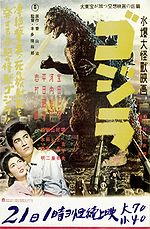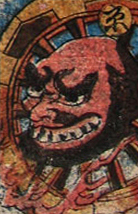Monster
This article needs additional citations for verification. (October 2016) |

A monster is any creature, usually found in legends or horror fiction, that is often hideous and may produce fear or physical harm by its appearance or its actions. The word "monster" derives from Latin monstrum, meaning an aberrant occurrence, usually biological, that was taken as a sign that something was wrong within the natural order.[1]
The word usually connotes something wrong or evil; a monster is generally morally objectionable, physically or psychologically hideous, or a freak of nature. It can also be applied figuratively to a person with similar characteristics like a greedy person or a person who does horrible things.
The root of monstrum is monere—which does not only mean to warn but also to instruct, and forms the basis of the modern English demonstrate. Thus, the monster is also a sign or instruction. This benign interpretation was proposed by Saint Augustine, who did not see the monster as inherently evil, but as part of the natural design of the world, a kind-of deliberate category error.[2]
Well-known monsters in fiction include Count Dracula, Frankenstein's monster, werewolves, mummies, and zombies.
Etymology

"Monster" comes from the Latin monstrum; the equivalent Greek word is theras, "beast."[3] Both of these words are associated with a variety of terms related to "divination" or "miracle".
In context to the religion of ancient Greeks and Romans, monsters were seen as signs of "divine displeasure", and it is thought that birth defects (i.e. teratology, from the Greek equivalent word) were especially ominous, being "an unnatural event" or "a malfunctioning of nature".[4]
However, not all "monsters" were abominations; Suetonius describes a snake's leglessness or a bird's ability to fly as monstrous, since both are "against nature".[5] Nonetheless, the negative connotations of the word quickly established themselves, and by the playwright Seneca's time the word had extended into its philosophical meaning, "a visual and horrific revelation of the truth".[6]
In spite of this, mythological monsters such as the Hydra and Medusa are not natural beings, but divine entities. This seems to be a holdover from Proto-Indo-European religion and other belief systems, in which the divisions between "spirit," "monster," and "god" were less evident.
Cultural history
Classical mythology, Celtic mythology, Ancient Semitic religion, Norse mythology, Chinese folklore, and Sumerian religion all had a wealth of legendary beasts.
The Sirens. First you will come to the Sirens who enchant all who come near them. If any one unwarily draws in too close and hears the singing of the Sirens, his wife and children will never welcome him home again, for they sit in a green field and warble him to death with the sweetness of their song. There is a great heap of dead men's bones lying all around, with the flesh still rotting off them.
— Homer, The Odyssey, XII, 52ff.
The Harpies. Saved from the sea, the Strophades we gain,
So called in Greece, where dwells, with Harpies,
Heavenly ire
Ne'er sent a pest more loathsome; ne'er were seen
Worse plagues to issue from the Stygian mire
Birds maiden-faced, but trailing filth obscene,
With taloned hands and looks for ever pale and lean.— Virgil, The Aeneid, III, 354ff.
Polyphemus. This was the abode of a huge monster who was then away from home shepherding his flocks. He would have nothing to do with other people [...] With a sudden clutch he gripped up two of my men at once and dashed them down upon the ground as though they had been puppies. Their brains were shed upon the ground, and the earth was wet with their blood. Then he tore them limb from limb and supped upon them.
— Homer, The Odyssey, IX, 235ff.
The Chimaera. The Chimaera, who was not a human being, but a goddess, for she had the head of a lion and the tail of a serpent, while her body was that of a goat, and she breathed forth flames of fire; but Bellerophon slew her, for he was guided by signs from heaven.
Monsters? There is also talk of other fabulous human portents, which are not real, but invented: they are symbols of a set reality. This is the case of Geryon, king of Spain, of whom it is said he was born with three bodies: in reality, there were three brothers who got on so well that it was almost as if the three bodies shared one soul. This is also the case with the Gorgons, prostitutes with snakes for hair, who with one look turned men into stone. They were said to have only one eye, which they took turns in using. In reality, they were three sisters all equally beautiful, almost as one to the eye, the sight of whom stunned men so much they fancied that the sisters had turned them into stone.
— Isidore of Seville, Etymologiae, XI, 3
Monsters in fiction
Film
Pre–World War II monster films

During the age of silent movies, monsters tended to be human-sized, e.g., Frankenstein's monster, the Golem, werewolves and vampires. The film Siegfried featured a dragon that consisted of stop-motion animated models, as in RKO's King Kong, the first giant monster film of the sound era.
Universal Studios specialized in monsters, with Bela Lugosi's reprisal of his stage role, Dracula, and Boris Karloff playing Frankenstein's monster. The studio also made several lesser films, such as Man-Made Monster, starring Lon Chaney, Jr. as a carnival side show worker who is turned into an electrically charged killer who dispatches victims merely by touching them, causing death by electrocution.
There was also a variant of Dr. Frankenstein, the mad surgeon Dr. Gogol (played by Peter Lorre), who transplanted hands that were reanimated with malevolent temperaments, in the film Mad Love.
Werewolves were introduced in films during this period, and similar creatures were presented in Cat People. Mummies were cinematically depicted as fearsome monsters as well. As for giant creatures, the cliffhanger of the first episode of the 1936 Flash Gordon serial did not use a costumed actor, instead using real-life lizards to depict a pair of battling dragons via use of camera perspective. However, the cliffhanger of the ninth episode of the same serial had a man in a rubber suit play the Fire Dragon, which picks up a doll representing Flash in its claws. The cinematic monster cycle eventually wore thin, having a comedic turn in Abbott and Costello Meet Frankenstein (1948).
Post World War II monster films

In the post World War II era, however, giant monsters returned to the screen with a vigor that has been causally linked to the development of nuclear weapons. One early example occurred in the American film The Beast from 20,000 Fathoms, which was about a dinosaur that attacked a lighthouse. Subsequently, there were Japanese film depictions, (Godzilla, Gamera), British depictions (Gorgo), and even Danish depictions (Reptilicus), of giant monsters attacking cities. A recent depiction of a giant monster is the monster in J. J. Abrams's Cloverfield, which was released in theaters January 18, 2008. The intriguing proximity of other planets brought the notion of extraterrestrial monsters to the big screen, some of which were huge in size, (such as King Ghidorah and Gigan), while others were of a more human scale. During this period, the fish-man monster Gill-man was developed in the film series Creature from the Black Lagoon.

Britain's Hammer Film Productions brought color to the monster movies in the late 1950s. Around this time, the earlier Universal films were usually shown on American television by independent stations (rather than network stations) by using announcers with strange personas, who gained legions of young fans. Although they have since changed considerably, movie monsters did not entirely disappear from the big screen as they did in the late 1940s.
Occasionally, monsters are depicted as friendly or misunderstood creatures. King Kong and Frankenstein's monster are two examples of misunderstood creatures. Frankenstein's monster is frequently depicted in this manner, in films such as Monster Squad and Van Helsing. The Hulk is an example of the "Monster as Hero" archetype. The theme of the "Friendly Monster" is pervasive in pop-culture. Chewbacca, Elmo, and Shrek are notable examples of friendly "monsters". The creatures of Monsters, Inc. scare children in order to create energy for running machinery, while the furry monsters of The Muppets and Sesame Street live in harmony with animals and humans alike. Japanese culture also commonly features monsters which are benevolent or likable, with the most famous examples being the Pokémon franchise and the pioneering anime My Neighbor Totoro. The book series/webisodes/toy line of Monster High is another example.
Prose fiction
Monsters are a staple of fantasy fiction, horror fiction or science fiction (where the monsters are often extraterrestrial in nature). There is also a burgeoning subgenre of erotic fiction involving monsters, monster erotica.
Games
Monsters are commonly encountered in fantasy or role-playing games and video games as enemies for players to fight against. They may include aliens, legendary creatures, extra-dimensional entities or mutated versions of regular animals.
Especially in role-playing games, "monster" is a catch-all term for hostile characters that are fought by the player. Sentient fictional races are usually not referred to as monsters. At other times, the term can carry a neutral connotation, such as in the Pokémon franchise, where it is used to refer to fictional creatures that resemble real-world animals, or in Undertale, where "monster" is synonymous with "person". Characters in games may refer to all animals as "monsters".
See also
Monsters in legend
- Beast of Gévaudan
- Behemoth
- Bishop-fish
- Canvey Island Monster
- Centaur
- Cerberus
- Changeling
- Charybdis
- Chimera
- Cryptozoology
- Cyclops
- Demon
- Dragon
- Fearsome Critters
- Fouke Monster
- Freak
- Ghoul
- Gorgons
- Homo monstrosus
- Mythological hybrid
- Jiangshi
- Jinn
- Kaiju
- Kelpie
- Lake monster
- Legendary creature
- Hydra
- Leviathan
- Midgard Serpent
- Minotaur
- Ogre
- Scylla
- Sea monster
- Swamp monster
- Tarasque
- Troll
- Werewolf
- Yeti
- Yōkai
Monsters in fiction
References
- ^ David Wardle, Cicero on Divination, Book 1 (Oxford University Press, 2006), p. 102; Mary Beagon, "Beyond Comparison: M. Sergius, Fortunae victor", in Philosophy and Power in the Graeco-Roman World: Essays in Honour of Miriam Griffin (Oxford University Press, 2002), p. 127; Gregory A. Staley, Seneca and the Idea of Tragedy (Oxford University Press, 2010), pp. 109, 113 et passim.
- ^ Saint Augustine, City of God, Book XXI, Chapter 8
- ^ Beagon, "Beyond Comparison", in Philosophy and Power, p. 127.
- ^ Mary Beagon, "Beyond Comparison: M. Sergius, Fortunae victor", in Philosophy and Power in the Graeco-Roman World: Essays in Honour of Miriam Griffin (Oxford University Press, 2002), p. 127.
- ^ As cited by Wardle, Cicero on Divination, p. 330.
- ^ Gregory A. Staley, Seneca and the Idea of Tragedy (Oxford University Press, 2010), pp. 80, 96, 109, 113 et passim.
- ^ Each card features a monster from Japanese mythology and a character from the hiragana syllabary.
